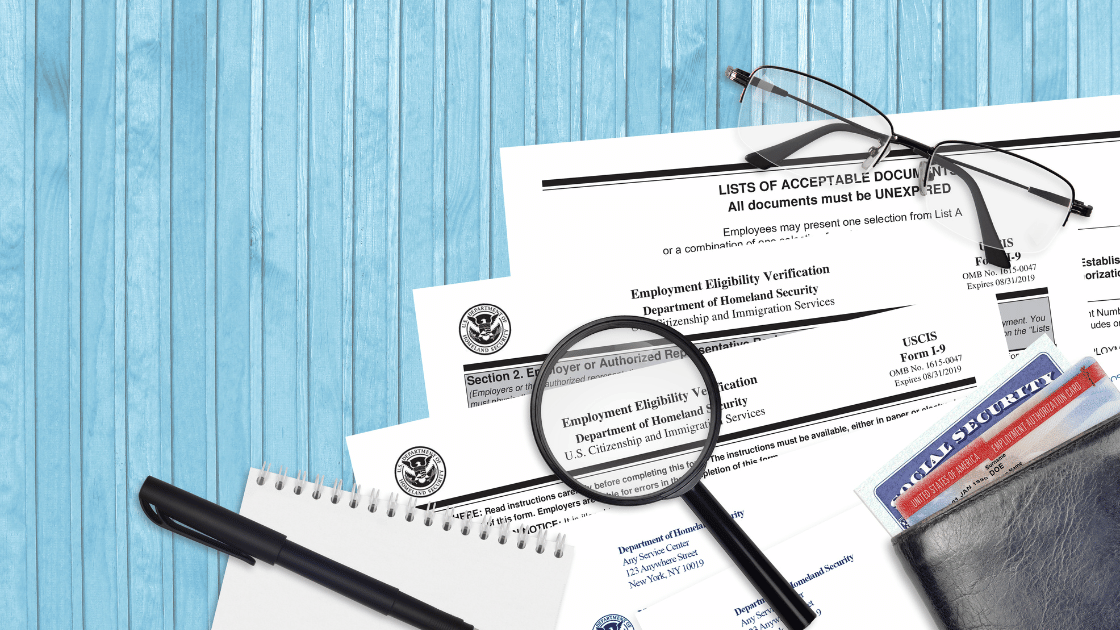Key Changes Coming to I-9 Verification
September 8, 2022
UPDATE: This blog has been updated to reflect the rule published by Homeland Security in the Federal Register on July 27, 2023. You can read the rule here.
Key Changes Coming to I-9 Verification
Employers "in good standing” receive permission to utilize virtual I-9 verification process
The US government made temporary allowances for virtual I-9 document verification during the pandemic and those accommodations were set to expire this summer for all employers. New rules, released at the end of July 2023 allow employers who use the federal government’s E-verify system and “are in good standing” to complete I-9 requirements for employees hired after August 1, 2023 via live video interaction.
Please note that the rule is not retroactive.
A new version of the I-9, which includes an option to indicate the document verification was completed via live video, will be available for download from the federal government on August 1, 2023. All previous versions of the I-9 must cease to be used as of October 31, 2023.
I-9 Verification Changes: What Does This Mean for Employers “in good standing” with E-Verify?
- Physical Inspection of Documents: For all new hires, a physical or live video inspection of required documents must occur starting on August 1, 2023. The employer may choose which type of inspection to conduct, so long as the inspection decisions about which employees receive each type of document review are not discriminatory.
- Virtual Verification Limitations: Employers using virtual verification methods during the pandemic (any employee hired on or after March 20, 2020 whose documents have not already been physically inspected), may be able to use the alternative procedure to reinspect documents no later than August 30, 2023, if certain conditions are met.
- According to the US Department of Homeland Security: “Qualified employers that 1) were enrolled in EVerify at the time they performed a remote document examination of an employee’s Form I-9 documentation for Section 2 or reverification while using the COVID-19 flexibilities, 2) created an E-Verify case for that employee (except for reverification), and 3) performed the remote inspection between March 20, 2020 and July 31, 2023, can use the alternative procedure to satisfy the required physical examination of the employee’s documents for that Form I-9.”
- Vault clients that utilize E-Verify through Vault’s background screening product generally qualify as “in good standing”. However, clients who utilized Vault’s product to screen only a portion of their workforce or who have been previously notified of past E-Verify issues by the US Department of Homeland Security may not qualify as “in good standing.”
- For employers that don’t meet that standard, they must conduct an in-person inspection of required form I-9 documents for any employee who had a virtual verification under the COVID-19 Pandemic accommodations. Reinspection must be completed by August 30, 2023.
- The following exceptions apply to the reverification requirement:
- Retention and Reverification: I-9s completed early in the pandemic may no longer be within the retention period and therefore may not be necessary to reinspect documents in person. Employers should fully audit their current employee populations and Form I-9 requirements before initiating a reverification process. Some documents for terminated employees may also fall outside the scope of retention and reverification requirements.
- Remote Employees Verification: Employers who do not meet the criteria for using the alternative live video reverification method may send an authorized representative to inspect documents, provided their policy and procedures are consistently applied across the workforce.
- For Vault Background Screening Clients: Vault’s platform can help employers coordinate the I-9 process with their authorized agents. In the platform, the employer can designate their agent or allow the applicant to recommend an agent to the employer to complete the physical inspection of documents. Vault’s system will then send a link to the employer's agent to complete the I-9 form process electronically.
- Potential Employer Penalties: The Department of Homeland Security (DHS) can assess fines for “paperwork deficiencies” and “Knowingly Employing Unauthorized Alien” violations, emphasizing the seriousness of these changes to employers.
I-9 Verification Changes: What Does This Mean for Employers who are not using E-Verify or not “in good standing”?
- Employers who do not meet the criteria for using the alternative procedure for I-9 verification and reverification should proceed consistent with previously announced federal requirements. This includes returning to physical verifications for all employees and conducting reverifications on employees and former employees still within the required document retention period.
- Through its background screening products, Vault can provide an E-Verify solution for employers that wish to use the virtual verification option but do not yet qualifty.
Important Considerations for Employers
- E-Verify System Limitation
The Department of Homeland Security limited the more flexible verification requirements to only employers using the federal E-Verify system. Vault Workforce Screening offers E-Verify to all clients utilizing its background screening platform, saving employers significant cost and complexity of individually registering for the E-Verify program on their own. With this new limitation in place, a rush by employers to sign up for E-Verify could delay approvals and implementation of new procedures in organizations awaiting an account and training.
- Permanent Virtual Verification
The new alternative verification method does not expire, meaning virtual verification methods used during the COVID-19 policies are permanent for qualified employers. While employers have become adept at accomplishing these document reviews, Vault Workforce Screening handles the verification burden on for its clients, freeing up HR staff to focus on critical recruitment and hiring for the many other open roles.
For more information:
2023-15533.pdf (federalregister.gov)
USCIS To Publish Revised Form I-9 | USCIS
2023-15667.pdf (federalregister.gov)
Beyond I-9 Verification
Finally, while an I-9 verification is the minimum required by law, many employers consider identity verification a crucial component of the background screening process to ensure their new employee is exactly who they say they are.
Identity Screening Options:
These choices range from the simple to the complex:
- Social Security Number trace via the background screening package
- Consent Based Social Verification via the background screening package
- Telecom and device verification
- Confirmation of identity data against regulated sources, known as Knowledge-Based Authentication or electronic Identify Verification
- Virtual ID authentication via email, fax, or portal submission
- Virtual facial recognition technology matched against an authenticated ID during live video chat
- Finger printing
Stay Updated with I-9 Compliance and Rule Changes
Want to know about I-9 rule changes in real time? Join Vault’s AI-powered daily industry newsletter for HR and Compliance professionals.
Ready to optimize your HR and compliance processes?
Book a no-obligation screening audit today.

